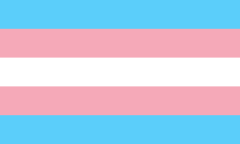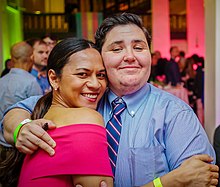
Back Transgender Afrikaans Transgeschlechtlichkeit ALS Transchenero AN تحول جنسي Arabic ট্ৰান্সজেণ্ডাৰ Assamese Tresxéneru AST Transgender Azerbaijani Трансгендарнасць Byelorussian Трансджендър Bulgarian রূপান্তরিত লিঙ্গ Bengali/Bangla
 | |
| Classification | Gender identity |
|---|---|
| Abbreviations | TG |
| Other terms | |
| Associated terms | Transsexual |
| Part of a series on |
| Transgender topics |
|---|
|
|
| Part of a series on |
| LGBT topics |
|---|
|
|
A transgender person (often shortened to trans person) is someone whose gender identity differs from that typically associated with the sex they were assigned at birth.[1] Some transgender people who desire medical assistance to transition from one sex to another identify as transsexual.[2][3] Transgender is also an umbrella term; in addition to including people whose gender identity is the opposite of their assigned sex (trans men and trans women), it may also include people who are non-binary or genderqueer.[4][5][6] Other definitions of transgender also include people who belong to a third gender, or else conceptualize transgender people as a third gender.[7][8] The term may also include cross-dressers or drag kings and drag queens in some contexts.[9] The term transgender does not have a universally accepted definition, including among researchers.[10][11]
Being transgender is distinct from sexual orientation, and transgender people may identify as heterosexual (straight), homosexual (gay or lesbian), bisexual, asexual, or otherwise, or may decline to label their sexual orientation.[12] The opposite of transgender is cisgender, which describes persons whose gender identity matches their assigned sex.[13] Accurate statistics on the number of transgender people vary widely,[14] in part due to different definitions of what constitutes being transgender.[10] Some countries, such as Canada, collect census data on transgender people.[15] Generally, fewer than 1% of the worldwide population are transgender, with figures ranging from <0.1% to 0.6%.[16][17][18]
Many transgender people experience gender dysphoria, and some seek medical treatments such as hormone replacement therapy, gender-affirming surgery, or psychotherapy.[19] Not all transgender people desire these treatments, and some cannot undergo them for financial or medical reasons.[19][20]
The legal status of transgender people varies by jurisdiction. Many transgender people experience transphobia, or violence or discrimination towards transgender people, in the workplace,[21] in accessing public accommodations,[22] and in healthcare.[23] In many places, they are not legally protected from discrimination.[24] Several cultural events are held to celebrate the awareness of transgender people, including Transgender Day of Remembrance and International Transgender Day of Visibility,[25][26] and the transgender flag is a common transgender pride symbol.[27]

- ^ "A glossary: Defining transgender terms". American Psychological Association. 49 (8): 32. September 2018. Archived from the original on 2023-07-12. Retrieved 2023-07-24.
- ^ Bevan, Dana J. (17 November 2014). The Psychobiology of Transsexualism and Transgenderism. Santa Barbara, California: ABC-Clio/Greenwood Publishing. p. 42. ISBN 9781440831270. OCLC 1021404840. Archived from the original on 15 May 2022. Retrieved 14 May 2022.
The term transsexual was introduced by Cauldwell (1949) and popularized by Harry Benjamin (1966) [...]. The term transgender was coined by John Oliven (1965) and popularized by various transgender people who pioneered the concept and practice of transgenderism. It is sometimes said that Virginia Prince (1976) popularized the term, but history shows that many transgender people advocated the use of this term much more than Prince.
- ^ Polly, Ryan; Nicole, Julie (March 2011). "Understanding transsexual patients: culturally sensitive care in emergency nursing practice". Advanced Emergency Nursing Journal. 33 (1): 55–64. doi:10.1097/TME.0b013e3182080ef4. PMID 21317698. S2CID 2481961. Archived from the original on 2022-03-11. Retrieved 2022-05-14.
The use of terminology by transsexual individuals to self-identify varies. As aforementioned, many transsexual individuals prefer the term transgender, or simply trans, as it is more inclusive and carries fewer stigmas. There are some transsexual individuals, however, who reject the term transgender; these individuals view transsexualism as a treatable congenital condition. Following medical and/or surgical transition, they live within the binary as either a man or a woman and may not disclose their transition history.
- ^ Forsyth, Craig J.; Copes, Heith (2014). Encyclopedia of Social Deviance. SAGE Publications. p. 740. ISBN 978-1483364698. Archived from the original on December 1, 2016. Retrieved April 12, 2016.
Transgender is an umbrella term for people whose gender identities, gender expressions, and/or behaviors are different from those culturally associated with the sex that they were assigned at birth.
- ^ Cite error: The named reference
GLAAD Media Referencewas invoked but never defined (see the help page). - ^ Bilodeau, Brent (21 October 2008). "Beyond the Gender Binary: A Case Study of Two Transgender Students at a Midwestern Research University". Journal of Gay & Lesbian Issues in Education. 3 (1). Routledge: 29–44. doi:10.1300/J367v03n01_05. S2CID 144070536. Archived from the original on 8 March 2021. Retrieved 14 May 2022.
Yet Jordan and Nick represent a segment of transgender communities that have largely been overlooked in transgender and student development research – individuals who express a non-binary construction of gender.
- ^ Stryker, Susan; Whittle, Stephen; Aizura, Aren Z. (18 October 2013). The Transgender Studies Reader. New York: Routledge; Hoboken: Taylor & Francis. p. 666. ISBN 978-1135398842. OCLC 1120816658. Archived from the original on 15 May 2022. Retrieved 14 May 2022.
The authors note that, increasingly, in social science literature, the term 'third gender' is being replaced by or conflated with the newer term 'transgender.'
- ^ Chrisler, Joan C.; McCreary, Donald R. (12 March 2010). Handbook of Gender Research in Psychology, Volume 1. New York; London: Springer Publishing. p. 486. ISBN 9781441914651. OCLC 647897357. Archived from the original on 15 May 2022. Retrieved 14 May 2022.
Transgender is a broad term characterized by a challenge of traditional gender roles and gender identity [...] For example, some cultures classify transgender individuals as a third gender, thereby treating this phenomenon as normative.
- ^ Reisner, S. L.; Conron, K.; Scout, N.; Mimiaga, M. J.; Haneuse, S.; Austin, S. B. (13 March 2014). "Comparing In-Person and Online Survey Respondents in the U.S. National Transgender Discrimination Survey: Implications for Transgender Health Research". LGBT Health. 1 (2): 98–106. doi:10.1089/lgbt.2013.0018. PMID 26789619. Archived from the original on 23 October 2021. Retrieved 14 May 2022.
Transgender was defined broadly to cover those who transition from one gender to another as well as those who may not choose to socially, medically, or legally fully transition, including cross-dressers, people who consider themselves to be genderqueer, androgynous, and…
- ^ a b "Transgender". Encyclopædia Britannica. Archived from the original on 2022-06-14. Retrieved 2022-06-14.
- ^ Cite error: The named reference
:0was invoked but never defined (see the help page). - ^ "Lesbian, Gay, Bisexual, and Transgender Health: Transgender Persons". CDC. U.S. Department of Health and Human Services. September 29, 2020. Archived from the original on 18 February 2021. Retrieved 21 November 2020.
- ^ Blank, Paula (2014-09-24). "Will the Word "Cisgender" Ever Go Mainstream?". The Atlantic. Archived from the original on 2018-05-13. Retrieved 2021-08-14.
- ^ Factsheet: Trans People in the UK (PDF) (Report). gov.uk. 3 July 2018. ISBN 9781786556738. Archived (PDF) from the original on 8 April 2022. Retrieved 29 May 2022.
- ^ Easton, Rob (27 April 2022). "'Historic' census data sheds light on number of trans and non-binary people for the first time". CBC.ca. Archived from the original on 27 April 2022. Retrieved 29 May 2022.
- ^ M.H. (Sep 1, 2017). "Why transgender people are being sterilised in some European countries". The Economist. Archived from the original on 2018-03-22. Retrieved 2022-05-22.
- ^ "What Percentage of the Population is Transgender 2022". World Population Review. Archived from the original on 2022-05-22. Retrieved 2022-05-22.
- ^ "Counting Trans Populations". Division of Prevention Science. Archived from the original on 2022-05-13. Retrieved 2022-05-22.
- ^ a b Maizes, Victoria; Low Dog, Tieraona (19 November 2015). Integrative Women's Health. Oxford University Press. p. 745. ISBN 978-0190214807.
Many transgender people experience gender dysphoria – distress that results from the discordance of biological sex and experienced gender. Treatment for gender dysphoria, considered to be highly effective, includes physical, medical, and/or surgical treatments [...] some [transgender people] may not choose to transition at all.
- ^ "Understanding Transgender People FAQ". National Center for Transgender Equality. 1 May 2009. Archived from the original on 22 April 2016. Retrieved 20 April 2016.
- ^ Lombardi, Emilia L.; Anne Wilchins, Riki; Priesing, Dana; Malouf, Diana (October 2008). "Gender Violence: Transgender Experiences with Violence and Discrimination". Journal of Homosexuality. 42 (1): 89–101. doi:10.1300/J082v42n01_05. PMID 11991568. S2CID 34886642.
- ^ "Groundbreaking Report Reflects Persistent Discrimination Against Transgender Community". Gay and Lesbian Alliance Against Defamation. February 4, 2011. Archived from the original on August 3, 2011. Retrieved December 14, 2021.
- ^ Bradford, Judith; Reisner, Sari L.; Honnold, Julie A.; Xavier, Jessica (2013). "Experiences of Transgender-Related Discrimination and Implications for Health: Results From the Virginia Transgender Health Initiative Study". American Journal of Public Health. 103 (10): 1820–1829. doi:10.2105/AJPH.2012.300796. PMC 3780721. PMID 23153142.
- ^ Whittle, Stephen (2002). Respect and equality : transsexual and transgender rights. London Portland, OR: Cavendish Pub. ISBN 978-1-85941-743-0. OCLC 810082841.
- ^ Cite error: The named reference
:1was invoked but never defined (see the help page). - ^ Cite error: The named reference
:2was invoked but never defined (see the help page). - ^ Cite error: The named reference
:3was invoked but never defined (see the help page). - ^ DiGuglielmo, Joey (11 May 2016). "Querry: Bianca Rey". Washington Blade. Archived from the original on 7 October 2020. Retrieved 28 November 2020.
- ^ Griggs, Brandon (1 June 2015). "America's transgender moment". CNN. Archived from the original on 9 March 2022. Retrieved 28 November 2020.
Hayden Mora, deputy chief of staff at the Human Rights Campaign and a transgender man....
© MMXXIII Rich X Search. We shall prevail. All rights reserved. Rich X Search